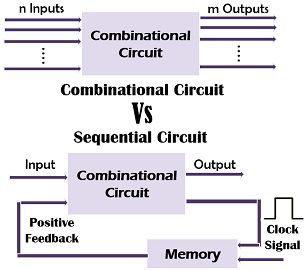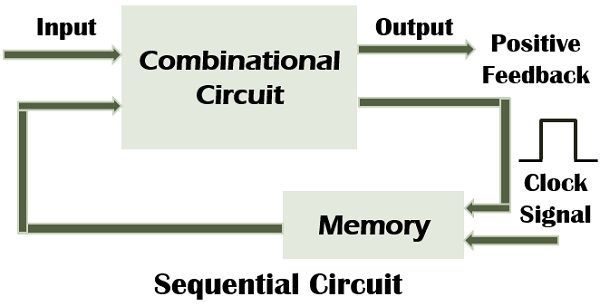 The crucial difference between combinational and sequential circuit is that combinational circuit result only relies on the input present at that instant while in the sequential circuit the output of the logic not just depends on the latest input but also on the earlier outputs. There is no feedback is provided to the combinational logic circuit but when it comes to the sequential logic circuit the feedback is the essential part of the circuit. So, the output generated considers both the present and past outputs.
The crucial difference between combinational and sequential circuit is that combinational circuit result only relies on the input present at that instant while in the sequential circuit the output of the logic not just depends on the latest input but also on the earlier outputs. There is no feedback is provided to the combinational logic circuit but when it comes to the sequential logic circuit the feedback is the essential part of the circuit. So, the output generated considers both the present and past outputs.
Content: Combinational Circuit Vs Sequential Circuit
Comparison Chart
| Basis for comparison | Combinational circuit | Sequential circuit |
|---|---|---|
| Basic | The output is discovered by the present state of the inputs. | Both the present input and past state output are used to identify the output. |
| Storage capability | Does not store data. | Can store a small amount of data. |
| Application | Used in adders, encoders, multiplexer, etcetera. | Flip-flop and latches. |
| Clock | Circuits do not rely on the clock. | Clock is utilized for performing triggering functions. |
| Feedback | No requirement of the feedback. | Feedback is required. |
Definition of Combinational Circuit
A combinational circuit is built up of the linked collection of several gates which produces output specific to the input at that instant. The basic AND, OR and NOT or universal gates NAND and NOR are the fundamental building blocks of the combinational circuit. As shown in the below-given diagram of the combinational circuit the output lines immediately follow the input lines. One of the typical examples of the combinational circuit is the decoder which is used to transform the binary code data into the decimal code data.
In these circuits, the output generated at that time would depend on the input of the particular time. There are three variations of the combinational logic circuits – arithmetic and logical functions, data transmission and code converters. The circuits included in the arithmetic and logic circuits are the adders, subtractors, comparators, PLDs, etcetera. Similarly, data transmission circuits are multiplexers, demultiplexers, encoders, decoders and so on. BCD and 7 segments are the code converter circuits.
Commonly, a combination circuit comprised of n number of binary inputs and m number of binary outputs. It implements the crucial functions of a digital computer.
The significant characteristics of the combinational circuit
- Truth table: It generates the ‘m’ number of binary output signals for the set of 2n input signals.
- Graphical symbol: Shows the linked layout of the gates.
- Boolean equations: The output signals are expressed in the form of the boolean function of input signals.
Definition of Sequential Circuit
A sequential circuit is a class of circuits where the outcome depends on both the present input and past outputs. The characteristic of this circuit is that the state of output changes according to the sequence of the input has been inserted. This means that the sequential circuits contain an amount of memory to store the immediate results.  For example, it can remember which logic level 0 or 1 is connected to its input and employ the fact at the output also. This memory device can be made up of the simple OR gate.
For example, it can remember which logic level 0 or 1 is connected to its input and employ the fact at the output also. This memory device can be made up of the simple OR gate.
There are various devices which implement sequential circuits such as latches, flip-flop, and registers. These inputs changes from one of the two states. The sequential circuits are categorised in two ways, synchronous and asynchronous circuits. The circuit is considered as synchronous when the internal state of the machine alters at the particular time driven by a clock.
Key Differences Between Combinational and Sequential Circuit
- As mentioned above the combinational circuits uses the latest input for generating the output whereas sequential input decides the output of the given input by considering the previous output also.
- The combinational circuit does not have any potential to store data. As against sequential circuits can store a specific amount of data.
- Sequential circuits are mainly used in flip-flops, latches and registers. On the contrary, combinational circuits are employed in the basic devices such as adders, subtracters, encoders and so on.
- There is no clock used in the combinational circuit. In contrast, sequential circuits implement a clock for performing triggering functions.
- The sequential circuit requires the feedback for its functioning. Conversely, the combinational circuit does not require any feedback.
Conclusion
The devices built using combinational circuit do not require the previous output for its operation. On the other hand, the sequential circuit needs the previous outputs for its functioning and producing the accurate results.
Shakir says
Helped me a lot today is my exam thanks
barbie says
Hello,
I have found this blog quite useful but I have a query:
How many combinational inputs does a 3-bit full adder contain?
Hope for your reply! Thank You.